Thank you for downloading this Simon & Schuster ebook.
Get a FREE ebook when you join our mailing list. Plus, get updates on new releases, deals, recommended reads, and more from Simon & Schuster. Click below to sign up and see terms and conditions.
CLICK HERE TO SIGN UP
Already a subscriber? Provide your email again so we can register this ebook and send you more of what you like to read. You will continue to receive exclusive offers in your inbox.
LEARN Sign
Language
in a Hurry

GRASP
THE BASICS OF
American
Sign
Language
Quickly and Easily
Irene Duke

Avon, Massachusetts
Copyright 2009 Simon and Schuster
All rights reserved.
This book, or parts thereof, may not be reproduced in any form without permission from the publisher; exceptions are made for brief excerpts used in published reviews.
Contains material adapted and abridged from The EverythingSign Language
Book, 2nd Edition, by Irene Duke, copyright 2009 Simon and Schuster,
ISBN 10: 1-59869-883-4, ISBN 13: 978-1-59869-883-1.
Published by
Adams Media, an imprint of Simon & Schuster, Inc.
57 Littlefield Street, Avon, MA 02322. U.S.A.
www.adamsmedia.com
ISBN 10: 1-59869-868-0
ISBN 13: 978-1-59869-868-8
eISBN: 978-1-44051-383-1
Printed in the United States of America.
J I H G F E D C B A
Library of Congress Cataloging-in-Publication Data
is available from the publisher.
This publication is designed to provide accurate and authoritative information with regard to the subject matter covered. It is sold with the understanding that the publisher is not engaged in rendering legal, accounting, or other professional advice. If legal advice or other expert assistance is required, the services of a competent professional person should be sought.
From a Declaration of Principles jointly adopted by a Committee of the
American Bar Association and a Committee of Publishers and Associations
Interior photographs: Joe Ciarcia / Symphony Photography
Interior illustrations: Elisabeth Lariviere
This book is available at quantity discounts for bulk purchases.
For information, please call 1-800-289-0963.
Contents
Introduction
Whether youre interested in learning sign language because you have a child who is deaf, have lost hearing yourself, need to sign at work, or are simply looking to pick up a new skill, congratulations! Youve taken the first step toward learning the art of American Sign Language.
As youll begin to understand in the upcoming chapters, sign language is more than just a series of hand gestures. It is a natural, flexible way of communicating that will tap your creativity and introduce you to the unique culture of the signing community. Have you ever wondered how babies can learn and communicate with sign language before they can speak? Its because using gestures to communicate with one another is instinctiveits a natural part of our shared human history. As youll learn in this book, American Sign Language uses these instinctive hand gestures (such as touching the throat to indicate thirst) coupled with body language and additional signs to incorporate the important elements of expression and intonation into your message.
Learn Sign Language in a Hurry will teach you how to combine natural hand gestures with eye movement, facial expressions, head movement, body posture, and other forms of body language to communicate with and understand people in the Deaf community. After practicing the signs and exercises in this book, you will be able to ask and answer questions, describe an encounter with an old friend, and use signs to paint a visual picture for your audience.
Each chapter in this book will build on the chapter before. You will start out by establishing a basic understanding of the rules of signing, and will then build your vocabulary and confidence as you continue to learn. Like most languages, sign language requires plenty of practice (often in front of a mirror) to get it right, but once youve developed some skill, a whole world of possibility awaits you. And if you need or want to learn basic sign language fastthis is the book for you!
01 / Sign Language Basics

SIGN LANGUAGE is a complete visual mode of communication. It is the third most used language in the United States and the fourth most used language worldwide. Conversations and information, using sign language, are conveyed visually rather than auditorily and are composed of precise handshapes and movements. Sign language users combine articulate hand movements, facial expressions, and head and body movements to communicate feelings, intentions, humor, complex and abstract ideas, and more.
American Sign Language
American Sign Language, known as ASL, is the natural native language of the American Deaf community. ASL is used as the primary form of communication in the daily lives of the Deaf. ASL is a full language with its own syntax, punctuation, and grammar. American Sign Language is composed of precise handshapes, palm positions, movements, and the use of space around the signer.
These elements, movements, and handshapes, supported by facial expressions and body language, are capable of conveying complex and abstract ideas. ASL is constantly evolving and often changes regionally. The following combined elements serve to make ASL an exciting, effective form of communication:
 ASL signs
ASL signs
 Limited fingerspelling
Limited fingerspelling
 Facial expressions
Facial expressions
 Body language
Body language
 Head movement
Head movement
 Use of space and directional movement
Use of space and directional movement
You will soon acquire, through visual sign images and accompanying instructions, a broad basic sign vocabulary. Please note that all of the images are displayed with the model facing you, the receiver/reader. In other words, simply think that someone is directly signing to you. Also, all images demonstrated throughout this book show a right-handed signer.
Just take a close look at these two images, which illustrate the signs for hello and sign. These two signs are a great beginning and among the most often used signs.

HELLO: The starting position of the hand is similar to a military salute. Then, simply wave your hand off your forehead.

SIGN: Position both hands in front of the chest with both index fingers extended, and palms facing each other. Circle your hands, alternately rotating them toward your body.
Next page


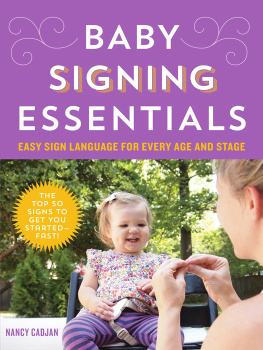
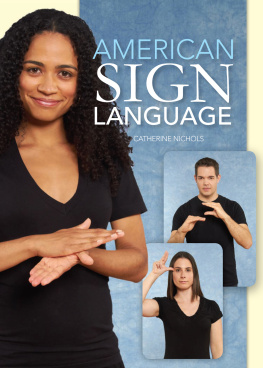
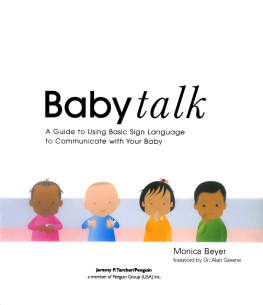
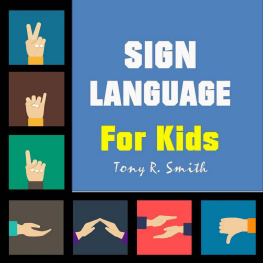

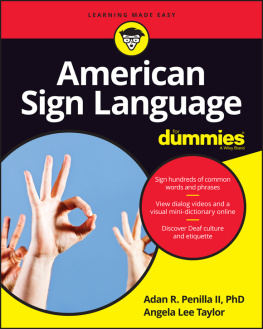




 ASL signs
ASL signs
